Understanding the Essentials of Mortuary Rooms
A mortuary room is a specialized facility designed for the temporary storage and preparation of deceased individuals before burial or cremation.
| Key Facts About Mortuary Rooms |
|---|
| Purpose: Temporary storage and preparation of deceased individuals |
| Temperature: Typically maintained between 2°C and 5°C (36°F to 41°F) |
| Common Features: Refrigerated cabinets or walk-in coolers, embalming tables, drainage systems, and sanitation stations |
| Different From: Morgues (hospital/forensic setting) and chapels of rest (viewing areas) |
| Access: Limited to licensed professionals and authorized personnel |
The mortuary room serves as the behind-the-scenes workspace of funeral homes, where trained professionals provide essential care for the deceased. Unlike what's portrayed on television, these spaces are practical, well-lit environments designed for efficiency, dignity, and safety.
Most funeral homes maintain a mortuary room with refrigeration units that can preserve bodies for several days to weeks, allowing time for funeral arrangements and family viewing. These units are critical in slowing decomposition while maintaining the dignity of the deceased.
For funeral directors, finding and equipping a proper mortuary room isn't just about compliance—it's about creating a space that honors both the dead and supports the living through their grief journey.
I'm Mortuary Cooler, a national supplier of mortuary refrigeration systems with extensive experience designing and installing mortuary room equipment across the United States. My work with mortuary room facilities has given me insight into the technical and human aspects of these essential spaces.
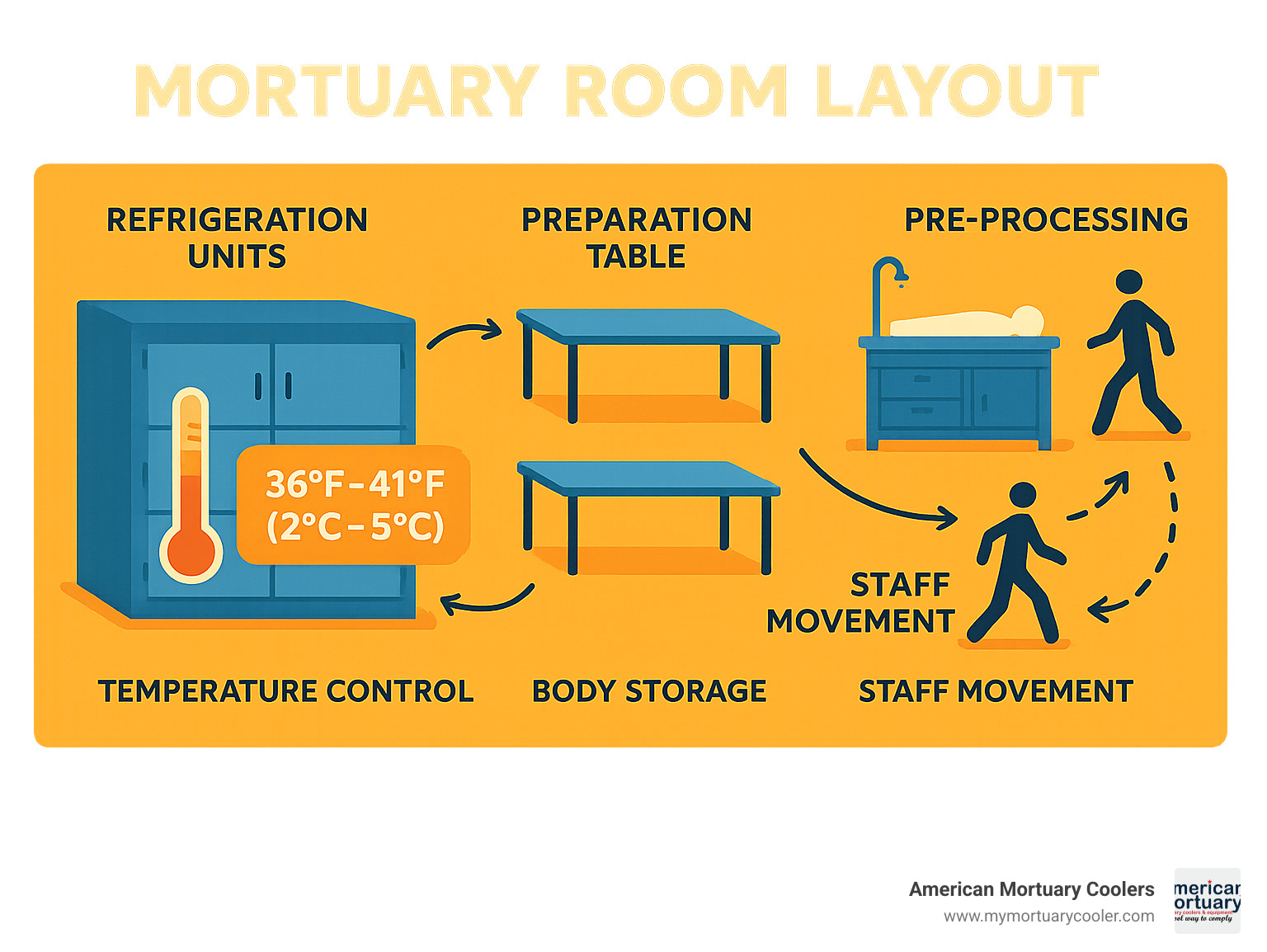
Simple mortuary room word guide:
- morgue refrigeration equipment
- do refrigerated bodies at hospital morgues smell bad
- refrigerated mobile morgue trailer
What Is a Mortuary Room?
A mortuary room is where life's final chapter is respectfully managed—a specialized facility where the deceased are received, stored, and prepared before their final journey to burial, cremation, or other disposition. Far from the eerie portrayal in movies, these spaces serve a deeply human purpose: providing a dignified, clean environment for temporary preservation while families begin their grief journey and make funeral arrangements.
At its heart, a mortuary room contains essential elements that balance technical needs with respectful care: refrigeration units that gently slow natural processes, preparation tables where final care is provided, and proper ventilation and drainage systems. Most loved ones stay in these facilities briefly—typically 3 to 10 days—though this timeline varies widely based on family needs, cultural traditions, and legal requirements.
"The primary purpose of a well-designed and organized preparation room is to provide a safe and comfortable workplace," as industry experts note. This thoughtful balance between functionality and respect is what distinguishes a proper mortuary room from makeshift alternatives.
The time a person remains in a mortuary room varies significantly around the world. Many cultural and religious traditions require burial within 72 hours of passing, while in other circumstances, bodies may need climate-controlled storage for weeks or even months—particularly during investigations or when family members must travel great distances to say goodbye.
The Mortuary Room vs. the Morgue
Though we often hear these terms used interchangeably in everyday conversation, a mortuary room and a morgue serve distinctly different purposes.
A morgue primarily functions as a temporary holding facility for those awaiting identification, autopsy, or transfer to funeral care. You'll typically find morgues in hospitals, medical examiner offices, or coroner facilities, where their primary role is medical and investigative rather than preparatory.
As one industry source explains: "A morgue is a temporary storage area usually in hospitals for autopsies and unclaimed bodies, while a mortuary offers services like embalming and on-site cremation."
The differences are meaningful: morgues are typically located in medical settings and staffed by healthcare personnel, while mortuary rooms exist within funeral homes under the care of licensed funeral directors and embalmers. Morgues focus on medical examination and identification, while mortuary rooms prepare loved ones for their final farewell. Public access to morgues is generally restricted, whereas mortuary rooms may occasionally permit family involvement in certain cultural or religious preparations.
In hospital settings, morgues often feature simple refrigerated storage units, while funeral home mortuary rooms contain more comprehensive preparation equipment including specialized embalming stations where care is provided with dignity and respect.
The Mortuary Room vs. the Chapel of Rest
Another important distinction exists between the working mortuary room and the peaceful chapel of rest. While the mortuary room serves as a preparation space, the chapel of rest is designed specifically for family viewing and paying final respects.
A chapel of rest is defined as "a private room in a funeral home where you can visit and pay your final respects to your loved one before the funeral service." Unlike the practical environment of a mortuary room, chapels of rest offer comfortable, peaceful spaces that provide privacy for grieving families.
The differences reflect their distinct purposes: mortuary rooms prioritize function and sanitation with technical equipment, while chapels of rest emphasize comfort and aesthetics with thoughtful seating, gentle lighting, and sometimes religious symbols. Most importantly, while mortuary rooms are restricted to trained professionals, chapels of rest welcome family and friends into a space designed for connection and farewell.
"A Chapel of Rest is a private, tranquil room in funeral homes where loved ones can pay final respects," explains one industry source. These spaces intentionally feel separate from the technical aspects of the mortuary room, creating a bridge between the practical needs of death care and the emotional needs of those who grieve.
Visiting a chapel of rest remains entirely optional. As one compassionate funeral director notes, "There is no right or wrong answer to whether you should visit the Chapel of Rest. Some find it helps with saying goodbye and the grieving process, while others choose to remember their loved ones as they were."
Key Features and Equipment of a Modern Mortuary Room
When you step into a modern mortuary room, you're entering a space thoughtfully designed to balance technical necessities with respectful care. At American Mortuary Coolers, we've installed equipment in funeral homes from our home in Johnson City, TN to busy urban centers like Los Angeles and New York, and everywhere in between.
The heart of any mortuary room is its refrigeration system. These come in several forms to suit different needs. Walk-in coolers provide space for multiple bodies and allow staff to move around comfortably inside. Individual refrigerated cabinets offer a more compact solution, typically holding 2-4 bodies in a stacked configuration. For facilities with space constraints, roll-in coolers provide flexibility with their ability to be moved as needed.
Temperature control is crucial in these spaces. Most mortuary room refrigeration maintains a careful balance between 2°C and 5°C (36°F to 41°F). This range is specifically chosen to slow decomposition without freezing tissues, which could damage them. For special circumstances like forensic cases or longer-term storage, negative-temperature chambers operating between -10°C and -50°F (-14°F to -58°F) provide additional preservation time.
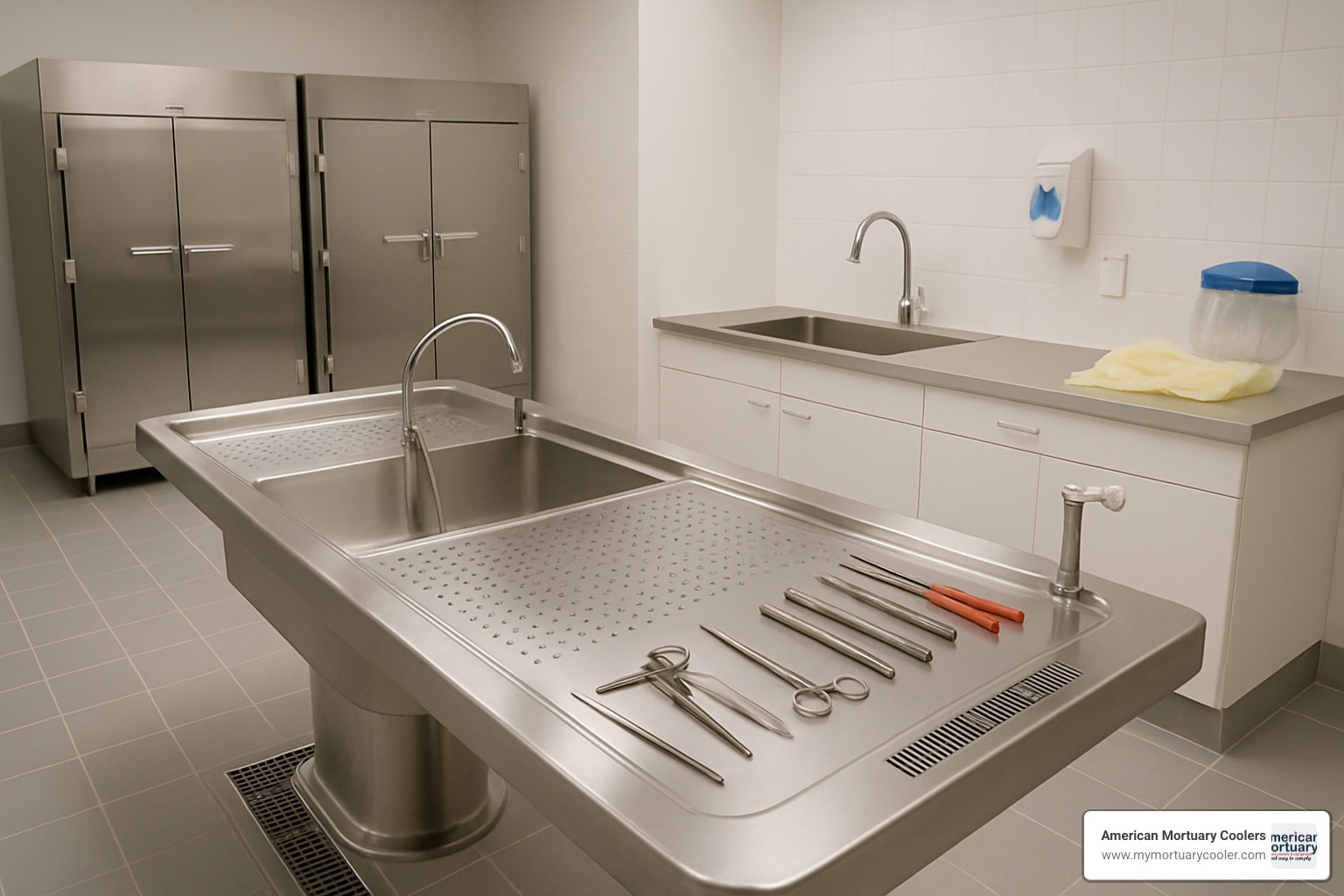
"When we upgraded our mortuary room with American Mortuary Coolers' equipment, we saw immediate improvements in workflow efficiency and staff safety," shared a Chicago funeral director we worked with recently. "The right equipment makes all the difference in providing dignified care."
Preparation tables form another cornerstone of the mortuary room. These are typically crafted from stainless steel or fiberglass, offering a non-porous surface that's easy to clean and disinfect. Modern tables often feature adjustable height settings (usually between 32-38 inches), built-in drainage systems, and weight capacities of approximately 1,000 pounds. For communities with diverse needs, specialized bariatric storage options ensure everyone receives the same level of care and respect.
Temperature Control Inside a Mortuary Room
The science behind mortuary room refrigeration is both straightforward and fascinating. At temperatures between 2°C and 5°C, bacterial growth dramatically slows, which delays the natural decomposition process. This careful balance preserves the body's condition for viewing and preparation.
Today's refrigeration systems include thoughtful features like digital thermostats with clear displays that allow staff to monitor conditions at a glance. Alarm systems provide peace of mind by alerting staff to any temperature fluctuations outside acceptable ranges. For regulatory compliance, data logging capabilities record temperature history, creating a verifiable record of proper care.
"We maintain our mortuary room refrigeration units between 1°C and 5°C," a Dallas funeral director told us recently. "This temperature range gives us the optimal balance between preservation and tissue integrity."
Power outages can happen anywhere, which is why backup power connections are essential in a mortuary room. These ensure continuous operation during emergencies, protecting both the deceased and the peace of mind of their families.
Essential Mortuary Room Equipment List
Beyond refrigeration, a fully equipped mortuary room requires specialized tools that support dignified care. Based on our experience outfitting facilities nationwide, here are the essentials:
For transport and handling, mortuary trolleys with adjustable height and locking wheels make movement safer and more dignified. Body lifts, whether ceiling-mounted or portable gantry systems, reduce staff strain and prevent injuries. Transfer boards and roller systems further support safe movement between surfaces.
The embalming process requires specialized equipment including embalming pumps (often called "Porti-Boy" pumps), arterial tubes and cannulas for fluid introduction, and trocars for cavity embalming. Fluid collection systems and aspiration equipment complete this essential setup.
Safety is paramount in a mortuary room, with autoclaves for instrument sterilization, disinfection stations strategically placed throughout, and sometimes UV light systems for additional sanitization. Proper ventilation systems with adequate air exchange (minimum 15 air changes per hour) protect staff health, while OSHA-compliant signage reminds everyone of best practices.
A funeral director from Atlanta shared with us, "When we renovated our mortuary room, we worked with American Mortuary Coolers to ensure we had not just the basic equipment, but the right configuration for our workflow. The difference in efficiency was remarkable."
For those looking to improve their facilities, we often recommend starting with an assessment of current capacity and workflow patterns. Sometimes, a thoughtful reorganization of existing equipment can significantly improve efficiency before investing in new systems. The goal is always the same: creating a space where the deceased can be cared for with dignity, and where staff can work safely and effectively.
Step-by-Step: How Bodies Are Received, Stored, and Prepared
The journey through a mortuary room follows a careful, dignified process that honors the deceased while maintaining safety standards. Having helped outfit hundreds of funeral homes across America, we've seen how this process works—and I'd like to walk you through what happens behind those doors.
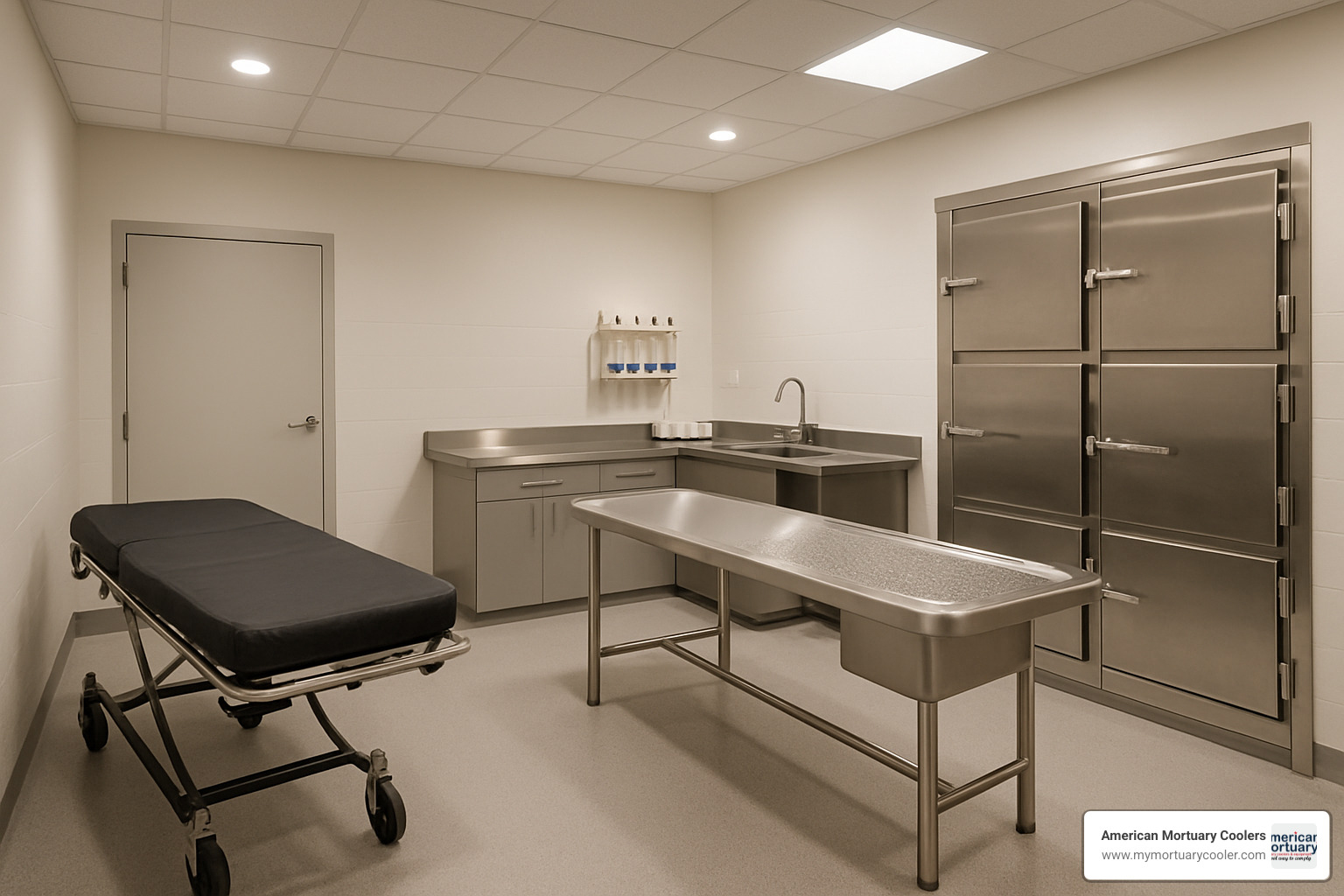
Receiving a Body into the Mortuary Room
When a loved one arrives at a funeral home's mortuary room, there's a careful protocol that begins immediately. First comes the paperwork—death certificates and transport authorizations create that all-important chain of custody. Think of it as the first step in keeping track of someone's final journey.
"We treat every arrival with the same care and respect we'd want for our own family members," explains a funeral director from our Nashville installation. "That starts with proper documentation."
Staff then verify the person's identity using multiple methods—typically wristbands, toe tags, and cross-checking with paperwork. This might seem excessive, but this redundancy ensures no mistakes happen during such an important time.
Personal belongings receive special attention too. Wedding rings, watches, eyeglasses—these items hold enormous sentimental value, so they're carefully cataloged and secured. As one mortician told me, "We document everything using a decedent care report. Families often ask about these items, and we need to know exactly where they are."
Before any physical contact, staff put on fresh gloves, gowns, and sometimes masks. "We keep boxes of gloves at every entrance," a funeral director from Memphis shared with a smile. "Running out is never an option." This isn't just about safety—it's about respect.
If preparation isn't starting immediately, the body goes into refrigeration. In the mortuary rooms we've equipped, this means a temperature between 2-5°C (36-41°F)—cool enough to slow natural processes without causing tissue damage.
Preparation Inside the Mortuary Room
Once the family has made their arrangements, the more detailed work begins. The body is gently moved from refrigeration to a preparation table—typically stainless steel with proper drainage systems that we've installed in hundreds of funeral homes.
The preparation area maintains a comfortable working temperature around 20-21°C (68-70°F), creating a dignified environment for this important work. Initial cleaning happens first, washing away any residue with warm water and gentle cleansers.
If the family has requested embalming, this preservation process begins next. Modern embalming is quite different from what many imagine. "We use a mechanical pump—what we sometimes call an 'artificial heart'—to replace blood with embalming fluid," explains a seasoned embalmer from one of our Kentucky installations. "It's more gentle and effective than the gravity methods used generations ago."
During this process, a small red head block is typically placed under the person's head. This isn't just for positioning—it helps prevent any unexpected fluid movement that might occur. It's these small details that make for a dignified process.
For those choosing not to embalm, refrigeration continues to play a vital role. Our walk-in coolers are designed to maintain perfect preservation conditions while allowing easy, respectful access for preparation.
Next comes what many consider the most personal part of preparation—dressing and cosmetics. The deceased is carefully dressed in clothes the family has provided. This might be a favorite suit, a beloved dress, or something with special meaning. Cosmetics are applied with a light touch, aiming for a natural, peaceful appearance.
"In our mortuary room, we're part scientist, part artist," shares a professional from our Pittsburgh facility. "The technical aspects matter, but so does creating a peaceful, natural appearance that helps families say goodbye."
Many families have specific cultural or religious requirements for preparation, and these are honored with great care. Whether it's ritual washing, specific positioning, or particular clothing requirements, the mortuary room is where these important traditions are carried out.
Finally, the deceased is positioned in their casket with careful attention to posture and appearance. Once everything is perfect, they're moved to the chapel of rest where family can visit in a comfortable, peaceful setting.
Throughout this entire journey, from arrival to final preparation, the goal remains the same: honoring someone's life with dignity, respect and care. It's why at American Mortuary Coolers, we take such pride in creating equipment that helps funeral professionals do this essential work.
Regulations, Safety & Cultural Considerations
Running a mortuary room isn't just about having the right equipment—it's about navigating a complex landscape of regulations while honoring the diverse traditions of the families we serve. At American Mortuary Coolers, we've worked with funeral homes from Maine to California, helping them create spaces that meet strict requirements while respecting cultural sensitivities.
Compliance Requirements for Every Mortuary Room
When we install refrigeration systems in a mortuary room, we're always mindful of the regulatory standards that govern these sacred spaces. These aren't just bureaucratic hoops to jump through—they're essential safeguards that protect both the deceased and the professionals who care for them.
OSHA has established clear guidelines for mortuary rooms, including proper ventilation with at least 15 air changes per hour. This isn't just about comfort—it's about removing potentially harmful vapors and maintaining a safe working environment. Most facilities we work with install permanent exhaust fans that exceed these minimums.
"Compliance isn't just about avoiding fines—it's about maintaining the highest standards of care and respect," shared a funeral director from our Chicago location. "In our mortuary room, we exceed minimum requirements because families deserve that level of commitment."
Beyond ventilation, proper facilities for staff are essential. This includes adjacent shower and locker rooms where professionals can change before returning home to their families. We've seen thoughtful designs where these areas create a meaningful transition space between the technical work of the mortuary room and the public-facing aspects of funeral service.
The electrical systems in a mortuary room require special attention too. All equipment must be properly grounded, and many facilities install dedicated circuits for critical refrigeration systems. This is especially important in older buildings, where we often need to upgrade electrical systems during cooler installations.
Documentation plays a crucial role in mortuary room compliance. Temperature logs must be maintained (typically twice daily) to ensure refrigeration systems are functioning properly. Many of our newer systems include digital monitoring that automatically records this data, but the principle remains the same—consistent temperature control is non-negotiable.
Regular inspections and licensing vary by state, but all mortuary rooms must meet local health department standards. This includes proper waste management systems, cleaning protocols, and separation of clean and dirty areas. The most successful facilities we work with develop comprehensive sanitation schedules that exceed minimum requirements.
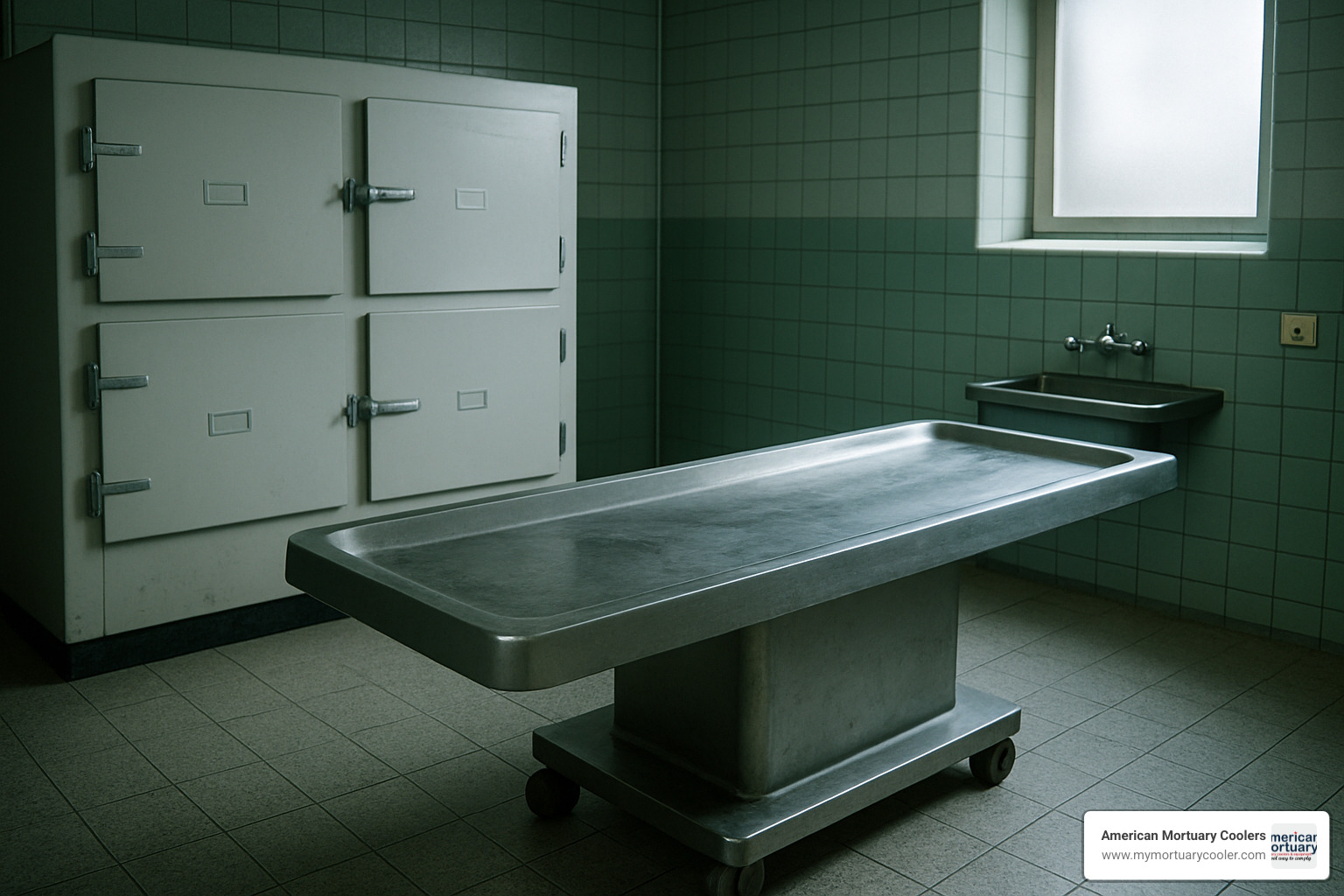
Adapting the Mortuary Room for Faith & Tradition
One of the most beautiful aspects of working with funeral homes across the country is seeing how mortuary rooms can be thoughtfully designed to honor diverse traditions. These aren't just technical spaces—they're sacred grounds where important cultural rituals take place.
For Jewish families, the mortuary room must accommodate the tahara, a ritual washing performed by the Chevra Kadisha (burial society). This requires specific considerations: the body must remain on a flat surface rather than being lifted, and traditional practice prohibits embalming. Some facilities we've worked with create dedicated spaces for shemira, the continuous watching over the deceased until burial.
Similarly, Islamic traditions include ghusl, a ritual washing typically performed by family members or community representatives. A respectful mortuary room design includes water drainage systems that allow for flowing water (rather than immersion), privacy screens, and space for multiple participants. The directional orientation of preparation tables may also be important for these rituals.
"We've designed our mortuary room to be adaptable to different cultural needs," explained a funeral director from our Dallas facility. "Movable equipment, adequate space for family participation, and specialized washing facilities make it possible to honor diverse traditions with dignity."
The growing interest in green burial has introduced new considerations for mortuary room design. These spaces may include areas for minimal preparation without chemical preservation, relying instead on natural cooling methods or short-term refrigeration. Documentation of preparation methods is often required for green cemetery requirements, creating another layer of protocol.
Some cultures and families request direct participation in or observation of preparation activities. A thoughtfully designed mortuary room might include a separate, comfortable area where family members can witness certain aspects of care while maintaining proper separation from technical areas. Accommodations for extended family participation might include wider doorways, additional space around preparation areas, or dedicated family entrance points.
During extraordinary circumstances like mass-casualty events or pandemics, mortuary rooms must be prepared to handle surge capacity. Many facilities we work with have developed emergency protocols that include temporary refrigeration solutions or mutual aid agreements with neighboring funeral homes. This kind of forward thinking ensures dignity is maintained even in the most challenging circumstances.
The best mortuary rooms we've helped create aren't just technically compliant—they're thoughtfully designed spaces that honor both regulatory requirements and human tradition. After all, this work isn't just about caring for the deceased—it's about supporting families through one of life's most difficult transitions.
More info about cooler specifications
Finding and Evaluating a Mortuary Room Near You
When you're faced with locating a mortuary room—whether you're planning ahead or dealing with an immediate loss—the process can feel daunting and unfamiliar. Here at American Mortuary Coolers, we've helped families across the country steer this challenging task, from our East Coast clients in New York to those on the West Coast in Los Angeles.
Start your search by looking in these key places:
Most hospitals maintain directories of their mortuary facilities, complete with information about access procedures and capabilities. Many funeral homes now offer virtual tours or detailed descriptions of their mortuary room facilities on their websites, making initial research easier. Your local health department is another valuable resource, as they typically maintain registries of all licensed funeral establishments with proper mortuary rooms. Professional organizations like the National Funeral Directors Association can also connect you with properly equipped facilities in your area.
"Most families never think about mortuary rooms until they need one," shares one of our funeral directors from our Tennessee headquarters. "But knowing what questions to ask can make all the difference during a difficult time."
When you're evaluating a potential mortuary room, don't hesitate to ask important questions. Inquire about their refrigeration capacity and whether they can accommodate your family's needs. If you have specific religious or cultural requirements, ask how they handle these special requests. It's also reasonable to ask about their backup plans for emergencies like power outages.
A funeral director from our New York location often tells families, "While you probably won't physically tour the preparation area, understanding a funeral home's mortuary room capabilities is absolutely your right as a consumer. The best funeral homes will be transparent about their facilities without you having to ask."
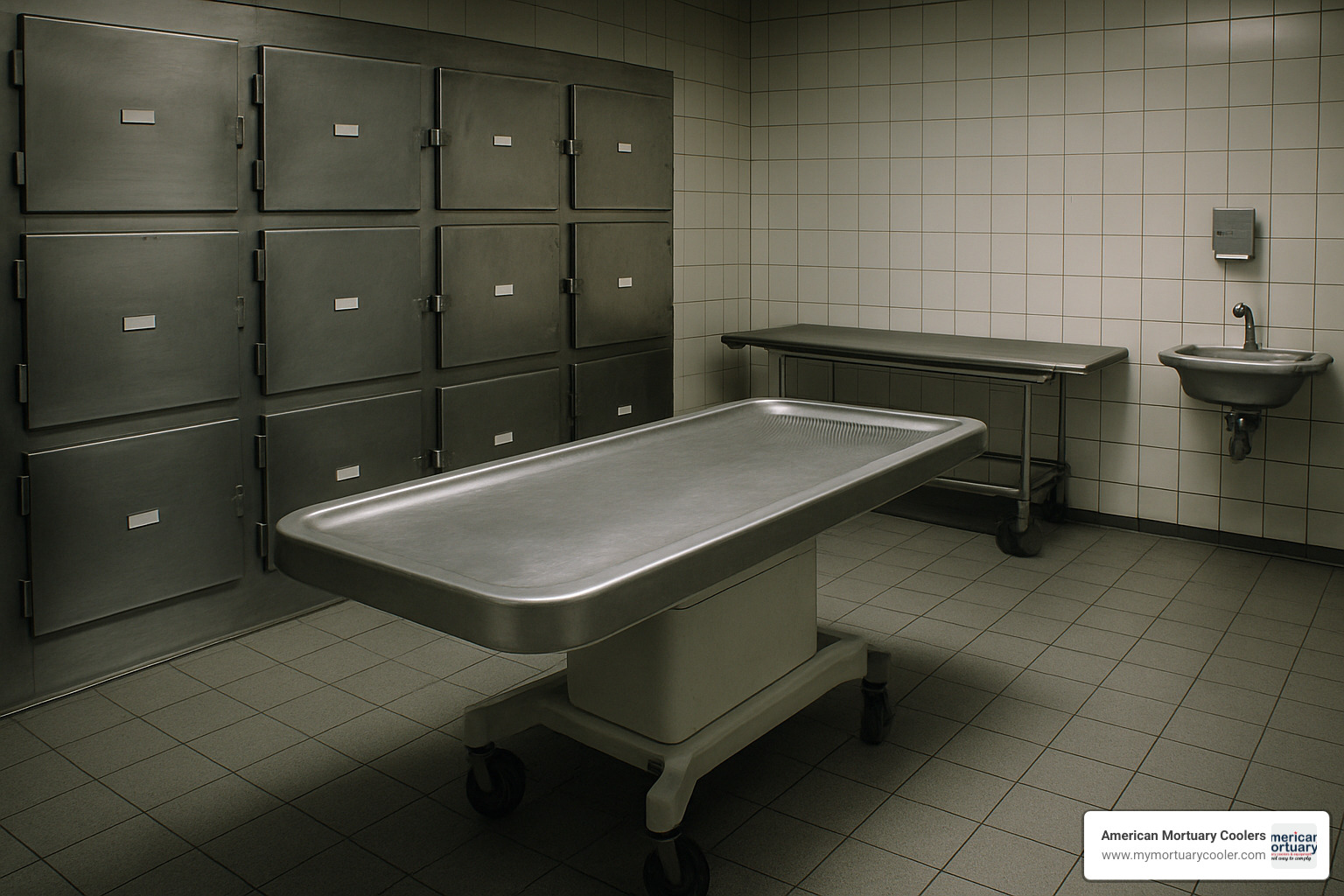
When the Nearest Mortuary Room Is at Capacity
Sometimes—especially during pandemic surges, natural disasters, or other mass-casualty events—mortuary rooms reach their capacity. Understanding the alternatives can help you steer these challenging situations.
Most funeral homes don't operate in isolation. They typically maintain overflow agreements with neighboring facilities to share resources during difficult times. This network of cooperation means that even if your first-choice location is at capacity, they can often help coordinate with another reputable provider.
In truly extraordinary circumstances, communities may implement temporary solutions. During COVID-19 peaks, we helped several clients in our Midwest region adapt refrigerated trucks and other temporary facilities to serve as dignified, functional mortuary room spaces.
"Even in the most challenging times, maintaining dignity is our primary concern," explains one of our specialists who worked through the pandemic. "When traditional mortuary rooms were overwhelmed, we helped facilities create temporary solutions that still honored the deceased and supported families."
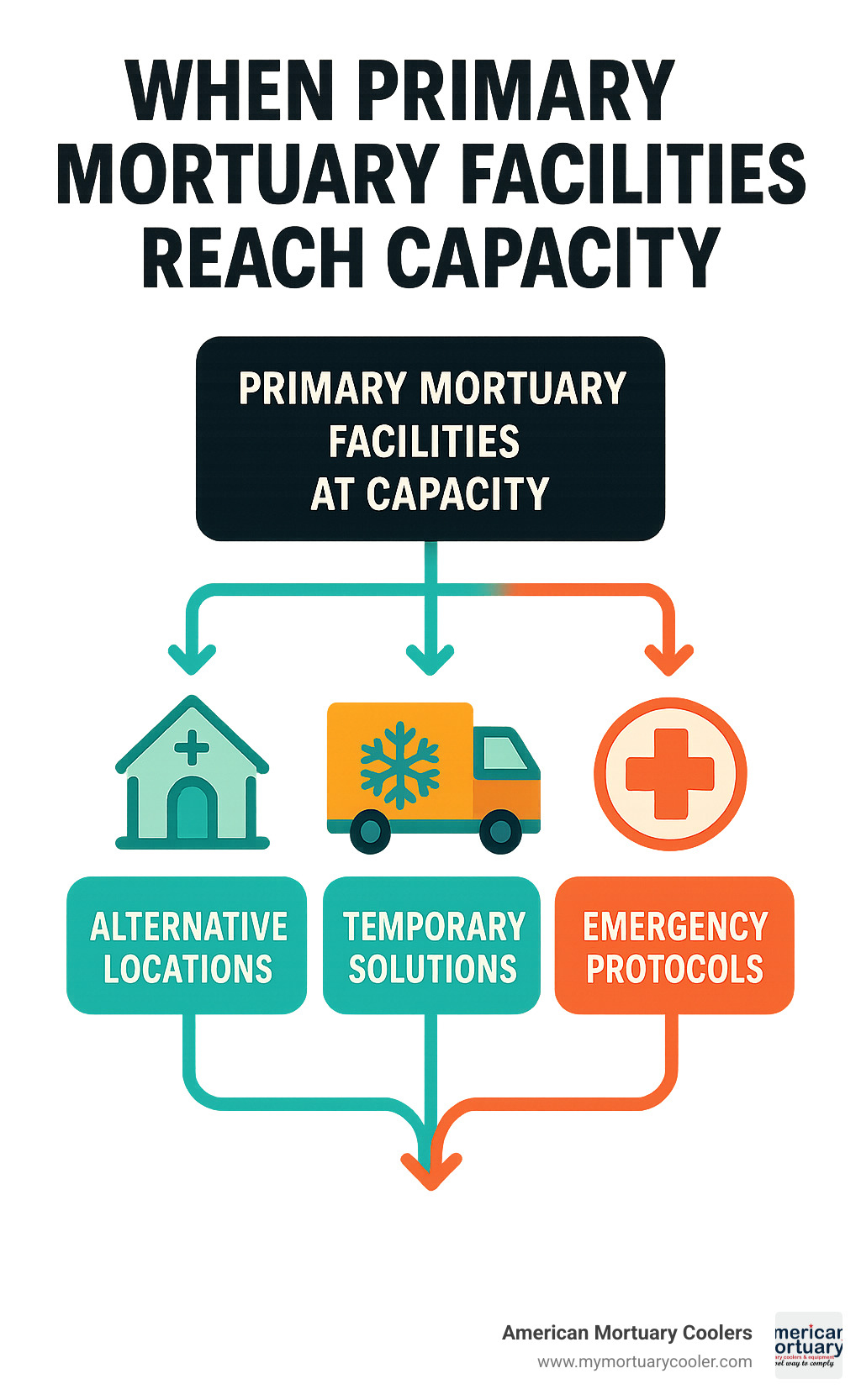
Upgrading or Building a Mortuary Room
For funeral professionals looking to upgrade their facilities, creating an effective mortuary room requires careful planning and consideration.
The first step is a thorough site assessment. You'll need adequate space—generally at least 120-150 square feet for smaller facilities handling up to 100 funerals annually. Proper ventilation is non-negotiable, and you'll need good accessibility for body transport. Look carefully at your utility connections and ensure the space offers appropriate privacy from public areas.
Material selection makes a significant difference in both functionality and maintenance. We recommend non-porous surfaces that can be easily cleaned and disinfected. Durable flooring with proper drainage prevents hazards and contamination. Most of our clients choose stainless steel or fiberglass preparation surfaces for their durability and ease of sanitation.
A funeral director from our Southwest region recently told us, "When we upgraded our mortuary room, we were working with a really challenging space. The team at American Mortuary Coolers helped us design a custom solution that maximized every square inch without compromising on quality or dignity."
Construction timelines can be a concern, especially for busy funeral homes that can't afford extended downtime. We've developed fast-track construction methods that minimize disruption, and our nationwide delivery network means we can source materials efficiently regardless of where you're located. Many of our clients opt for phased implementation, allowing them to maintain operations throughout the upgrade process.
When it comes to budgeting, refrigeration units typically range from $5,000 for basic models to $35,000+ for advanced systems. Beyond equipment costs, you'll need to consider installation, utility connections, and ongoing maintenance. Many of our clients find that investing in energy-efficient systems pays dividends through reduced operating costs over time.
At American Mortuary Coolers, we specialize in crafting custom mortuary room solutions that are delivered directly to funeral homes across all 48 contiguous states. Our team works closely with you to evaluate your specific needs and design a system that balances efficiency, dignity, and regulatory compliance—because we believe every community deserves access to proper facilities, regardless of location.
Frequently Asked Questions about Mortuary Rooms
How cold is a mortuary room supposed to be?
When families ask about temperature in a mortuary room, they're often surprised to learn there's a precise science behind it. The refrigeration units in these facilities maintain bodies at a careful balance between 2°C and 5°C (36°F to 41°F).
This specific range isn't arbitrary—it's the sweet spot where decomposition processes slow significantly without causing the tissue damage that freezing would create. It's like the Goldilocks principle of body preservation: not too warm, not too cold, but just right.
"In our daily checks of the mortuary room refrigeration systems, we're looking for that consistent 2-5°C range," shares one of our funeral directors from Tennessee. "It's one of those behind-the-scenes details that makes a tremendous difference in providing families with peaceful, dignified viewing experiences."
For special situations requiring longer preservation, we also maintain negative-temperature chambers that operate much colder, between -10°C and -50°C (-14°F to -58°F). Meanwhile, the main preparation area where our staff works stays at a comfortable room temperature around 20-21°C (68-70°F)—because while the deceased need cooling, our embalmers need a comfortable environment to provide their best care.
Who is allowed inside a mortuary room?
The question of access to a mortuary room often comes up when families are making arrangements. These spaces maintain strict privacy policies, with access generally limited to:
- Licensed funeral directors and embalmers who have completed extensive professional training
- Apprentices working under direct supervision of licensed professionals
- Authorized maintenance personnel who keep equipment running safely
- Health inspectors and regulatory officials during scheduled inspections
- In certain circumstances, family members participating in religious preparation rituals (always with proper guidance and protective equipment)
"Our mortuary room is essentially a sacred space," explains a funeral director from our Nashville location. "We balance the need for privacy and dignity with the meaningful cultural traditions that sometimes involve family participation in preparation."
Children and the general public typically don't enter these areas—partly for regulatory reasons, but mostly out of respect for the dignity of those in our care. There are occasional exceptions for educational purposes, such as mortuary science students, or for specific religious practices where family involvement is integral to proper care of the deceased.
How long can a body stay in a mortuary room?
Time is often a pressing concern for families, and questions about how long their loved one can remain in our care are common. The answer depends on several interconnected factors:
Legal requirements vary significantly by state, with many jurisdictions setting maximum timeframes of 3-10 days for an unembalmed body. Religious considerations can be even more specific—some traditions require burial within 24 hours, while others specify a three-day timeline.
"We work closely with each family to honor their traditions while navigating practical considerations," notes our facility manager in Memphis. "Our mortuary room refrigeration systems give us flexibility to accommodate different timelines, whether that means expediting preparation for a prompt burial or providing extended care while distant relatives arrange travel."
Embalming makes a substantial difference in these timelines. An unembalmed body in our standard refrigeration units (2-5°C) can typically be preserved properly for about a week, while embalmed remains can be maintained for significantly longer periods when necessary.
For extraordinary circumstances—international family travel, legal investigations, or during disaster situations—our specialized negative-temperature units can maintain remains for extended periods, sometimes months if absolutely necessary. However, we always encourage timely arrangements when possible, as this often helps families move forward in their grief journey.
At American Mortuary Coolers, we've designed our refrigeration systems with these varied needs in mind, providing funeral homes across all 48 contiguous states with reliable, efficient solutions that maintain dignity while accommodating diverse family needs and traditions.
Conclusion
The mortuary room stands as one of the most essential yet least understood spaces in our communities. These specialized facilities provide the dignified care, temporary preservation, and professional preparation that allows families to honor their loved ones through meaningful funeral rituals.
At American Mortuary Coolers, we're proud to support funeral professionals across all 48 contiguous states with custom-designed refrigeration solutions that meet the unique needs of each facility. From our home base in Johnson City, Tennessee, our teams serve funeral homes everywhere—from the misty mountains of the Northeast to the sunny shores of the Pacific coast.
"A well-designed mortuary room isn't just about having the right equipment," shares our lead designer. "It's about creating a space where caring professionals can provide the most respectful care possible during a family's most difficult moments."
We've seen how the right equipment transforms the way funeral directors work. One of our clients in Michigan told us, "Since upgrading our mortuary room with American Mortuary Coolers, our team feels more confident and capable. That peace of mind translates directly to how we care for families."
Whether you're a funeral professional looking to upgrade your facilities or someone seeking to understand the journey your loved one will experience, we hope this guide has provided valuable insights into the purpose, equipment, and processes of the modern mortuary room.
For those interested in learning more about our custom walk-in coolers and other mortuary room equipment, our team is available to answer your questions with the same care and attention we put into designing our products. We believe that by supporting funeral professionals with the right tools, we help them better support families during their time of grief.
The mortuary room may not be a place most people think about until they need one, but its role in providing dignified, respectful care makes it an essential part of how we honor those we've lost and support those left behind. At American Mortuary Coolers, we're honored to play a small but important role in that sacred work.
To learn more about our leading cooler solutions for funeral homes across America, visit our information page about mortuary refrigeration options.


















